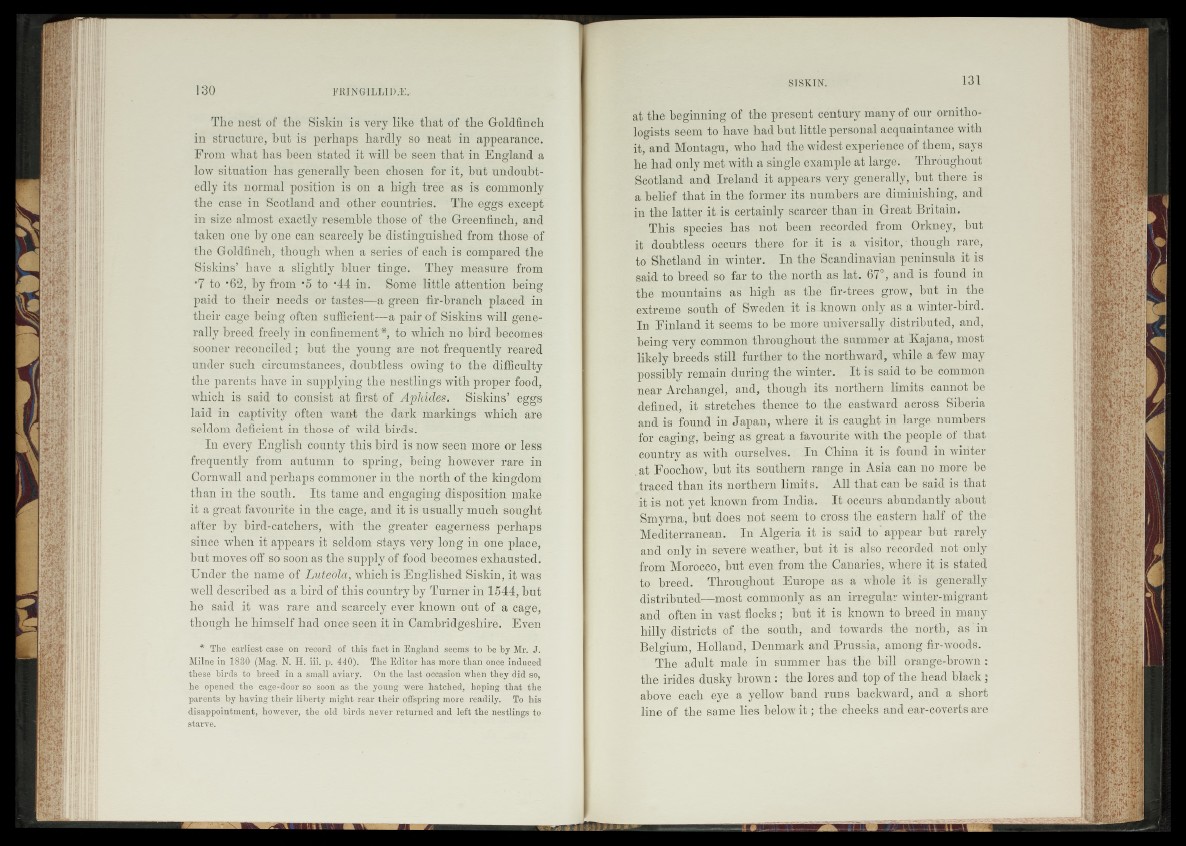
The nest of the Siskin is very like that of the Goldfinch
in structure, but is perhaps hardly so neat in appearance.
From what has been stated it will be seen that in England a
low situation has generally been chosen for it, but undoubtedly
its normal position is on a high tree as is commonly
the case in Scotland and other countries. The eggs except
in size almost exactly resemble those of the Greenfinch, and
taken one by one can scarcely be distinguished from those of
the Goldfinch, though when a series of each is compared the
Siskins’ have a slightly bluer tinge. They measure from
‘7 to *62, by from -5 to ‘44 in. Some little attention being
paid to their needs or tastes—a green fir-branclx placed in
their cage being often sufficient—a pair of Siskins will generally
breed freely in confinement*, to which no bird becomes
sooner reconciled; but the young are not frequently reared
under such circumstances, doubtless owing to the difficulty
the parents have in supplying the nestlings with proper food,
which is said to consist at first of Aphides. Siskins’ eggs
laid in captivity often want the dark markings which are
seldom deficient in those of wild birds.
In every English county this bird is now' seen more or less
frequently from autumn to spring, being however rare in
Cornwall and perhaps commoner in the north of the kingdom
than in the south. Its tame and engaging disposition make
it a great favourite in the cage, and it is usually much sought
after by bird-catchers, with the greater eagerness perhaps
since when it appears it seldom stays very long in one place,
but moves off so soon as the supply of food becomes exhausted.
Under the name of Luteola, which is Englished Siskin, it was
well described as a bird of this country by Turner in 1544, but
he said it was rare and scarcely ever known out of a cage,
though he himself had once seen it in Cambridge shire. Even
* The earliest case on record of this fact in England seems to be by Mr. J.
Milne in 1830 (Mag. N. H. iii. p. 440). The Editor has more than once induced
these birds to breed in a small aviary. On the last occasion when they did so,
he opened the cage-door so soon as the young were hatched, hoping that the
parents by having their liberty might rear their offspring more readily. To his
disappointment, however, the old birds never returned and left the nestlings to
starve.
SISKIN. 131
at the beginning of the present century many of our ornithologists
seem to have had but little personal acquaintance with
it, and Montagu, who had the widest experience of them, says
he had only met with a single example at large. Throughout
Scotland and Ireland it appears very generally, but there is
a belief that in the former its numbers are diminishing, and
in the latter it is certainly scarcer than in Great Britain.
This species has not been recorded from Orkney, but
it doubtless occurs there for it is a visitor, • though rare,
to Shetland in winter. In the Scandinavian peninsula it is
said to breed so far to the north as lat. 67°, and is found in
the mountains as high as the fir-trees grow, but in the
extreme south of Sweden it is known only as a winter-bird.
In Finland it seems to be more universally distributed, and,
being very common throughout the summer at Kajana, most
likely breeds still further to the northward, while a -few may
possibly remain during the winter. It is said to be common
near Archangel, and, though its northern limits cannot be
defined, it stretches thence to the eastward across Siberia
and is found in Japan, where it is caught in large numbers
for caging, being as great a favourite with the people of that
country as with ourselves. In China it is found in whiter
.at Foochow, but its southern range in Asia can no more be
traced than its northern limits. All that can be said is that
it is not yet known from India. It occurs abundantly about
Smyrna, but does not seem to cross the eastern half of the
Mediterranean. In Algeria it is said to appear but rarely
and only in severe weather, but it is also recorded not only
from Morocco, but even from the Canaries, where it is stated
to breed. Throughout Europe as a whole it is generally
distributed—most commonly as an irregular winter-migrant
and often in vast flocks; but it is known to breed in many
hilly districts of the south, and towards the north, as in
Belgium, Holland, Denmark and Prussia, among fir-woods.
The adult male in summer has the bill orange-brown :
the irides dusky brown : the lores and top of the head black
above each eye a yellow band runs backward, and a short
line of the same lies below i t ; the cheeks and ear-coverts are